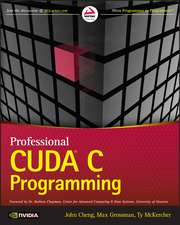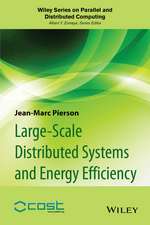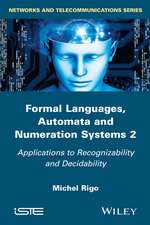Computer Architecture: A Minimalist Perspective: The Springer International Series in Engineering and Computer Science, cartea 730
Autor William F. Gilreath, Phillip A. Laplanteen Limba Engleză Hardback – 31 mar 2003
| Toate formatele și edițiile | Preț | Express |
|---|---|---|
| Paperback (1) | 984.18 lei 6-8 săpt. | |
| Springer Us – 5 noi 2012 | 984.18 lei 6-8 săpt. | |
| Hardback (1) | 990.80 lei 6-8 săpt. | |
| Springer Us – 31 mar 2003 | 990.80 lei 6-8 săpt. |
Din seria The Springer International Series in Engineering and Computer Science
- 24%
 Preț: 1041.97 lei
Preț: 1041.97 lei - 20%
 Preț: 643.50 lei
Preț: 643.50 lei - 18%
 Preț: 1225.62 lei
Preț: 1225.62 lei - 18%
 Preț: 965.02 lei
Preț: 965.02 lei - 20%
 Preț: 646.12 lei
Preț: 646.12 lei - 18%
 Preț: 948.79 lei
Preț: 948.79 lei - 20%
 Preț: 646.62 lei
Preț: 646.62 lei - 15%
 Preț: 637.46 lei
Preț: 637.46 lei - 20%
 Preț: 643.83 lei
Preț: 643.83 lei - 18%
 Preț: 949.23 lei
Preț: 949.23 lei - 20%
 Preț: 644.48 lei
Preț: 644.48 lei - 20%
 Preț: 994.92 lei
Preț: 994.92 lei - 20%
 Preț: 645.97 lei
Preț: 645.97 lei - 18%
 Preț: 946.87 lei
Preț: 946.87 lei - 20%
 Preț: 995.57 lei
Preț: 995.57 lei - 18%
 Preț: 956.99 lei
Preț: 956.99 lei - 20%
 Preț: 644.98 lei
Preț: 644.98 lei - 15%
 Preț: 649.54 lei
Preț: 649.54 lei - 18%
 Preț: 950.21 lei
Preț: 950.21 lei - 18%
 Preț: 1221.38 lei
Preț: 1221.38 lei - 18%
 Preț: 957.62 lei
Preț: 957.62 lei - 15%
 Preț: 643.99 lei
Preț: 643.99 lei - 18%
 Preț: 948.47 lei
Preț: 948.47 lei - 18%
 Preț: 947.35 lei
Preț: 947.35 lei - 20%
 Preț: 1284.65 lei
Preț: 1284.65 lei - 20%
 Preț: 1628.31 lei
Preț: 1628.31 lei - 20%
 Preț: 1285.78 lei
Preț: 1285.78 lei
Preț: 990.80 lei
Preț vechi: 1238.51 lei
-20% Nou
Puncte Express: 1486
Preț estimativ în valută:
189.58€ • 198.48$ • 156.87£
189.58€ • 198.48$ • 156.87£
Carte tipărită la comandă
Livrare economică 05-19 aprilie
Preluare comenzi: 021 569.72.76
Specificații
ISBN-13: 9781402074165
ISBN-10: 1402074166
Pagini: 240
Ilustrații: XV, 220 p.
Dimensiuni: 155 x 235 x 19 mm
Greutate: 0.52 kg
Ediția:2003
Editura: Springer Us
Colecția Springer
Seria The Springer International Series in Engineering and Computer Science
Locul publicării:New York, NY, United States
ISBN-10: 1402074166
Pagini: 240
Ilustrații: XV, 220 p.
Dimensiuni: 155 x 235 x 19 mm
Greutate: 0.52 kg
Ediția:2003
Editura: Springer Us
Colecția Springer
Seria The Springer International Series in Engineering and Computer Science
Locul publicării:New York, NY, United States
Public țintă
ResearchCuprins
1. One Instruction Set Computing.- 1.1 What is One Instruction Set Computing?.- 1.2 Why Study OISC?.- 1.3 A Look Ahead.- 1.4 Exercises.- 2 Instruction Sets.- 2.1 Elements of an Instruction.- 2.2 Operands.- 2.3 Instruction Formats.- 2.4 Core Set of Instructions.- 2.5 Addressing Modes.- 2.6 Exercises.- 3 Types of Computer Architectures.- 3.1 Overview.- 3.2 A Simple Taxonomy.- 3.3 Accumulator.- 3.4 Register-Memory.- 3.5 Register-Oriented.- 3.6 Exercises.- 4 Evolution of Instruction Sets.- 4.1 Motivation.- 4.2 Evolution of Microprocessors.- 4.3 Timeline.- 4.4 Exercises.- 5 CISC, RISC, OISC.- 5.1 CISC versus RISC.- 5.2 Is OISC a CISC or RISC?.- 5.3 Processor Complexity.- 5.4 Exercises.- 6 OISC Architectures.- 6.1 Single Instruction Types.- 6.2 MOVE.- 6.3 Comparing OISC Models.- 6.4 Variants of SBN and MOVE.- 6.5 OISC Continuum.- 6.6 Exercises.- 7 Historical Review of OISC.- 7.1 Subtract and Branch if Negative (SBN).- 7.2 MOVE-based.- 7.3 Timeline.- 7.4 Exercises.- 8 Instruction Set Completeness.- 8.1 Instruction Set Completeness.- 8.2 A Practical Approach to Determining Completeness.- 8.3 Completeness of Two OISCs.- 8.4 Exercises.- 9 OISC Mappings.- 9.1 Mapping OISC to Conventional Architectures.- 9.2 Synthesizing Instructions.- 9.3 Code Fragments.- 9.4 Implementing OISC using OISC.- 9.5 Exercises.- 10 Parallel Architectures.- 10.1 Von Neumann Bottleneck.- 10.2 Parallel Processing.- 10.3 Flynn’s Taxonomy for Parallelism.- 10.4 Exercises.- 11 Applications and Implementations.- 11.1 “OlSC-like” Phenomena.- 11.2 Field Programmable Gate Arrays.- 11.3 Applications.- 11.4 Image Processing.- 11.5 Future Work with OISC.- 11.6 Exercises.- Appendix A: A Generic Microprocessor and OISC.- Appendix B: One Instruction Set Computer Implementation.- B.1 6502 Opcodes Summary.- B.2 6502Opcodes Mapped to MOVE OISC.- B.3 6502 Addressing as MOVE-based OISC.- B.4 6502 Addressing Modes and MOVE-based OISC.- Appendix C: Dilation Code Implementation.- Appendix D: Compiler Output for Dilation.- Appendix E: OISC Equivalent of Dilation.- References.- About the Authors.
Recenzii
`This book gives a fine introduction to basic computer architecture. A few years ago, this book would have interested only graduate computer science and engineering students. These days, some high school students even create Linux clusters, and interest in it may be even more widespread.'
R.P. Sarna, Maine Maritime Academy in Choice, December 2003
R.P. Sarna, Maine Maritime Academy in Choice, December 2003
Textul de pe ultima copertă
The one instruction set computer (OISC) is the ultimate reduced instruction set computer (RISC). In OISC, the instruction set consists of only one instruction, and then by composition, all other necessary instructions are synthesized. This is an approach completely opposite to that of a complex instruction set computer (CISC), which incorporates complex instructions as microprograms within the processor. Computer Architecture: A Minimalist Perspective examines computer architecture, computability theory, and the history of computers from the perspective of one instruction set computing - a novel approach in which the computer supports only one, simple instruction. This bold, new paradigm offers significant promise in biological, chemical, optical, and molecular scale computers. Features include: · Provides a comprehensive study of computer architecture using computability theory as a base. · Provides a fresh perspective on computer architecture not found in any other text. · Covers history, theory, and practice of computer architecture from a minimalist perspective. Includes a complete implementation of a one instruction computer. · Includes exercises and programming assignments.
Computer Architecture: A Minimalist Perspective is designed to meet the needs of a professional audience composed of researchers, computer hardware engineers, software engineers computational theorists, and systems engineers. The book is also intended for use in upper division undergraduate students and early graduate students studying computer architecture or embedded systems. It is an excellent text for use as a supplement or alternative in traditional Computer Architecture Courses, or in courses entitled "Special Topics in Computer Architecture."
Computer Architecture: A Minimalist Perspective is designed to meet the needs of a professional audience composed of researchers, computer hardware engineers, software engineers computational theorists, and systems engineers. The book is also intended for use in upper division undergraduate students and early graduate students studying computer architecture or embedded systems. It is an excellent text for use as a supplement or alternative in traditional Computer Architecture Courses, or in courses entitled "Special Topics in Computer Architecture."
Caracteristici
The one instruction set computer (OISC) is the ultimate reduced instruction set computer (RISC). In OISC, the instruction set consists of only one instruction, and then by composition, all other necessary instructions are synthesized. This is an approach completely opposite to that of a complex instruction set computer (CISC), which incorporates complex instructions as microprograms within the processor. Computer Architecture: A Minimalist Perspective examines computer architecture, computability theory, and the history of computers from the perspective of one instruction set computing - a novel approach in which the computer supports only one, simple instruction. This bold, new paradigm offers significant promise in biological, chemical, optical, and molecular scale computers. Features include: · Provides a comprehensive study of computer architecture using computability theory as a base. · Provides a fresh perspective on computer architecture not found in any other text. · Covers history, theory, and practice of computer architecture from a minimalist perspective. Includes a complete implementation of a one instruction computer. · Includes exercises and programming assignments. Computer Architecture: A Minimalist Perspective is designed to meet the needs of a professional audience composed of researchers, computer hardware engineers, software engineers computational theorists, and systems engineers. The book is also intended for use in upper division undergraduate students and early graduate students studying computer architecture or embedded systems. It is an excellent text for use as a supplement or alternative in traditional Computer Architecture Courses, or in courses entitled "Special Topics in Computer Architecture."






